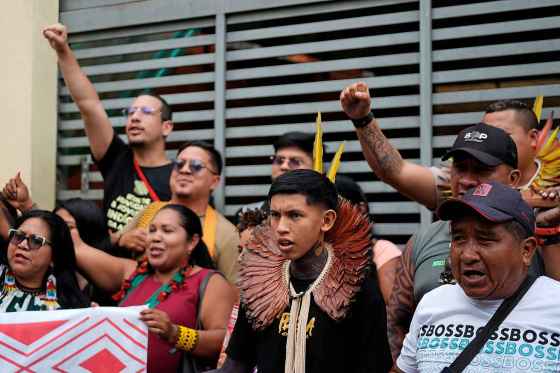FIVE STORIES ON TURTLE ISLAND
The United Nations Climate Change Conference, or Conference of the Parties of the UNFCCC (best known as Cop30) started this week in Brazil.
Seconds after the conference began, Indigenous activists from local communities and from throughout the world disrupted the gathering, demanding Indigenous rights be included and recognized by multinational corporations and world governments.
The issue of land theft from Indigenous communities and violence against Indigenous leaders is particularly stark in Brazil, which has a long history — and is worse than ever today — of colonialism and genocide.
Approximately 50,000 people from more than 190 countries are expected to attend the 11-day meeting to discuss the global climate crisis, but Indigenous peoples — even though they are impacted disproportionately and have vast ecological knowledge — are barely represented.

Indigenous peoples shout slogans about defending the Amazon at the People’s Summit, a gathering coinciding with the COP30 U.N. Climate Summit. (Fernando Llano / The Associated Press)
Indigenous leaders throughout Canada expressed fairly universal disappointment in the first budget presented by Prime Minister Mark Carney and his federal government last week. They also expressed deep concern surrounding the end of funding for many programs focused on reconciliation.
While Indigenous Services and Indigenous-Crown Relations received a lower cut (two per cent) than other federal departments, a chart in the back of the budget document revealed while certain Indigenous services received one-year top-ups covering education, child welfare, emergency management, and urban programs, subsequent years promised no funding whatsoever.
Asked about the “zeroes” in the planning chart, Indigenous Services Minister Mandy Gull-Masty told media to “not worry” and all that shows is “we haven’t defined what that space looks like.”
Research from the Canadian Journal of Opthalmology says that one-third of Indigenous peoples in Canada go without adequate eye care and access to optometrists.
It also says failing to address the eye care needs of Indigenous communities will hinder the development of adequate solutions, leading to profound inequities, poor eye-health outcomes and greater vision loss among this population.
This also explains why myopia, high degrees of astigmatism and age-related macular degeneration exists more often in Indigenous communities.
This is why organizations such as the Canadian Association of Optometrists have called this issue a “public health imperative” and needs “swift action.”
This week Hockey Canada announced their first Indigenous Advisory Circle (IAC).
The group will guide efforts to advance reconciliation with Indigenous Peoples in the game and help implement the Truth and Reconciliation Commission’s Calls to Action 87 to 91 throughout the organization.
Dr. Wilton Littlechild, former TRC commissioner and a Hall of Fame inductee in Canadian sports, is the circle’s inaugural chair.
There are three Manitobans on the IAC:
- Tréchelle Bunn (Birdtail Sioux Dakota Nation),
- Breanne Dondo (Red River Métis Nation) and
- Kevin Monkman (Ebb and Flow First Nation).
Fun fact: I played hockey with Kevin in 1987 for the Ashern Hornets youth hockey program and we were awesome (okay, he was awesome).
The Canadian Armed Forces took some big leaps this year.
First there was the national apology by CAF officials for the racist treatment of Indigenous veterans on October 30.
Then came Manitoba’s Bill 210, the Indigenous Veterans Day Act, which makes November 8 an official observance after the day was first observed in Winnipeg in 1993 and in Manitoba in 1994.
Then came this week’s announcement CAF veterans and officials can wear Indigenous-crafted poppies as “official” dress on Remembrance Day.
As the grandson of multiple military veterans — and in particular my grandpa Henry Sinclair, who fought for the Toronto Scottish in the Second World War — it is very healing to see so many honour ceremonies for some of this country’s most overlooked and mistreated heroes.
IN PICTURES

Garapira Pataxo, from the Pataxo Indigenous community, plays an instrument outside the venue for the COP30 U.N. Climate Summit, Tuesday in Belem, Brazil. (Andre Penner / The Associated Press)
RECONCILI-ACTION OF THE WEEK
Every week I highlight an action, moment, or milestone forwarding reconciliation, illustrating how far Canada has come — and how far the country has yet to go.
This week’s reconcili-action of the week is for the popular sports-brand Nike, which introduced their new N7 collection this week that “honors connections to the land with running footwear and versatile apparel.”
Featuring earth-themed colours, graphics and tones worn by Native American athletes and models, the runners look pretty cool.
For nearly 25 years, Nike has been investing in Indigenous communities through their N7 Fund, which supports sport and physical activity for Indigenous youth, and the N7 Collection, which features products designed with cultural inspiration.
Some of the funds raised also go to non-profit organizations that directly support Indigenous communities.
|

